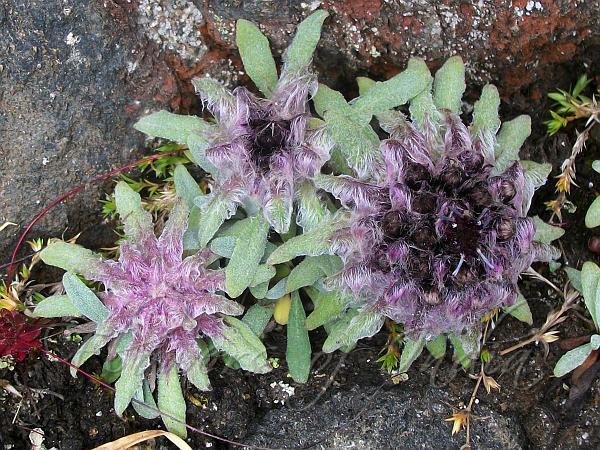|
| Inverse Snow Lotus |
|

|

|
|
|
|
Photo: |
Botanical name: Saussurea inversa Family: Asteraceae (Sunflower family)
Synonyms: Saussurea sorocephala var. glabrata, Saussurea hypsipeta var. glabrata
Synonyms: Saussurea sorocephala var. glabrata, Saussurea hypsipeta var. glabrata
Inverse Snow Lotus is a perennial herb 3-15 cm
tall. Caudex simple or branched at ground level. Stem is solitary, 2-5
mm in diameter, erect, simple. Rosette and lower stem leaves are
long-stalked. Leaves are narrowly obovate-spoon-shaped, elliptic, or
oblong, 1-3 x 0.3-1 cm, both surfaces green but sometimes tinged purple
and glabrous or sparsely white cobwebby, base narrow, margin obtusely
toothed or entire, tip blunt. Upper stem leaves are stalkless, narrowly
triangular-ovate, usually reflexed, both surfaces white and blackish
hairy, margin toothed or entire, tip blunt to long-pointed.
Flower-heads are 5-15, in a hemispheric cluster 2-4 cm in diameter,
stalkless. Involucre is cylindric, 5-6 mm in diameter. Phyllaries are
in about 3 rows, membranous, outer phyllaries narrowly elliptic-linear,
8-9 x 1.5-2 mm, densely black and white woolly. Middle and inner
phyllaries are obovate-elliptic, 8-9 x 2-3 mm, tip pointed. Receptacle
bristles 0.5-1.5 mm. Florets are rose-purple, 7-8 mm, tube 3-4 mm, limb
3.5-4 mm, petals 1.5-2 mm. Seed-pods are brown, cylindric to obconic,
4-5 mm, smooth, hairless. Pappus is mouse-gray to blackish; outer
bristles 1-3 mm, reflexed and appressed on achene; inner bristles 7-8
mm. Inverse Snow Lotus is found on alpine scree slopes, alpine meadows,
at altitudes of 3700-5400 m, in China, Ladakh and Kashmir. Flowering:
July-September.
| Identification credit: Bernhard Dickore, Suresh Rana, Gurcharan Singh | Photographed in Zara Valley, Ladakh & Paddar Valley, Kashmir. |
• Is this flower misidentified? If yes,